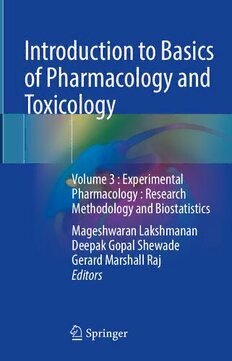
Introduction to Basics of Pharmacology and Toxicology: Volume 3: Experimental Pharmacology : Research Methodology and Biostatistics PDF
Preview Introduction to Basics of Pharmacology and Toxicology: Volume 3: Experimental Pharmacology : Research Methodology and Biostatistics
Introduction to Basics of Pharmacology and Toxicology Volume 3 : Experimental Pharmacology : Research Methodology and Biostatistics Mageshwaran Lakshmanan Deepak Gopal Shewade Gerard Marshall Raj Editors 123 Introduction to Basics of Pharmacology and Toxicology (cid:129) Mageshwaran Lakshmanan (cid:129) Deepak Gopal Shewade Gerard Marshall Raj Editors Introduction to Basics of Pharmacology and Toxicology Volume 3 : Experimental Pharmacology : Research Methodology and Biostatistics Editors MageshwaranLakshmanan DeepakGopalShewade DepartmentofPharmacology DepartmentofPharmacology ThanjavurMedicalCollege JawaharlalInstituteofPostgraduateMedical Thanjavur,TamilNadu,India EducationandResearch(JIPMER) Puducherry,Pondicherry,India GerardMarshallRaj DepartmentofPharmacology AllIndiaInstituteofMedicalSciences (AIIMS)Bibinagar Hyderabad,Telangana,India ISBN978-981-19-5342-2 ISBN978-981-19-5343-9 (eBook) https://doi.org/10.1007/978-981-19-5343-9 #SpringerNatureSingaporePteLtd.2022 Thisworkissubjecttocopyright.AllrightsarereservedbythePublisher,whetherthewholeorpartofthe materialisconcerned,specificallytherightsoftranslation,reprinting,reuseofillustrations,recitation, broadcasting,reproductiononmicrofilmsorinanyotherphysicalway,andtransmissionorinformation storageandretrieval,electronicadaptation,computersoftware,orbysimilarordissimilarmethodology nowknownorhereafterdeveloped. Theuseofgeneraldescriptivenames,registerednames,trademarks,servicemarks,etc.inthispublication doesnotimply,evenintheabsenceofaspecificstatement,thatsuchnamesareexemptfromtherelevant protectivelawsandregulationsandthereforefreeforgeneraluse. The publisher, the authors, and the editorsare safeto assume that the adviceand informationin this bookarebelievedtobetrueandaccurateatthedateofpublication.Neitherthepublishernortheauthorsor theeditorsgiveawarranty,expressedorimplied,withrespecttothematerialcontainedhereinorforany errorsoromissionsthatmayhavebeenmade.Thepublisherremainsneutralwithregardtojurisdictional claimsinpublishedmapsandinstitutionalaffiliations. ThisSpringerimprintispublishedbytheregisteredcompanySpringerNatureSingaporePteLtd. The registered company address is: 152 Beach Road, #21-01/04 Gateway East, Singapore 189721, Singapore Dedicated to the “three institutes” that made me what I am now—Govt Tuticorin medical College, JIPMER, and Thanjavur Medical College. Mageshwaran Lakshmanan Thanjavur, Tamil Nadu, India May 2022 Dedicated to all my mentors including my parents (for their love, care, and affection), my darling “chinnu” @ Dr. Rekha (for her unconditional love and exceptional support), and finally to my little wonder Gershin and cutie pie Riya (for lending their time). AndinlovingmemoryofmydearBalabalajee Sir! Gerard Marshall Raj Hyderabad, India May 2022 Foreword ItakepleasureinwritingtheForewordforVolumeIIIofIntroductiontoBasicsof Pharmacology and Toxicology being edited by Drs. Mageshwaran Lakshmanan, DeepakGopalShewade,andGerardMarshallRaj.Thisparticularvolumedealswith experimental pharmacology, biochemical pharmacology (instrumentation in drug analysis),researchmethodology,andbiostatistics. At present, due to several reasons like advances in biotechnology, the internet, and an improvement in the economy, leading to great numbers of scientific researchers, biomedical research is advancing at an unprecedented pace and rate. This research also involves basic and clinical pharmacology and new drugs are comingoutintothemarketatarapidpace.Inthislight,thecontentsofthisvolume willbeveryusefulforthoseinthebusinessofstudyingaboutandbringingoutnew drugs. This is because this volume covers many important topics in experimental pharmacology, several important drug screening methods, and instrumentation in drug analysis. In addition, the book has two important sections, one on research methodologyandtheotheronbiostatistics. This volume, as well as the other three volumes of this work, will be of great value to M.D. students in pharmacology as well as M.Pharm. students, M.Sc. pharmacology students, Ph.D. in pharmacology students, as well as all others engagedinteachingandresearchinginpharmacologyanditsalliedsciences. DepartmentofPharmacology JacobPeedicayil andClinicalPharmacology, ChristianMedicalCollege Vellore,TamilNadu,India vviiii Preface to Volume 1: General and Molecular Pharmacology: Principles of Drug Action (https://link.springer.com/book/10.1007/978- 981-32-9779-1) It was in the mid-2016s, when I had been in the phase of transformation from a postgraduatestudenttoateachingfaculty,thisideaofwritingabookespeciallyfor M.D.Pharmacology postgraduates came outfromnowhere.Thoughit wasalight- bulbthought,Ihadbeenruminatingonthatsincethen. And it was in the late 2017s and early 2018s, I had actually started working on thisherculeantask.ThefirstthingIdidwastobrowsethroughthevarioussyllabiof Indian Universities imparting M.D. Pharmacology course. I could retrieve (online search) around 20 syllabi of Universities in India from the States of Bihar, Delhi, Karnataka, Kerala, Madhya Pradesh, Maharashtra, Odisha, Puducherry (UT), Punjab, Tamil Nadu, Uttar Pradesh, and West Bengal. Then, I sifted through the coursecontentsandalsotherecommendedreferencebooksandtextbookstofinalize thetopicstobecovered. The ultimate goal of this book is to cater to a prospective M.D. Pharmacology postgraduate appearing for his/her formative or summative (final) assessment examinations.Hence,Ihaddividedthebookintoexampaper-wisevolumes. Volume1:GeneralandMolecularPharmacology:PrinciplesofDrugaction (cid:129) dealsaboutGeneralPharmacology Volume2:EssentialsofSystemicPharmacology:FromPrinciplestoPractice (cid:129) dealsaboutSystemicPharmacology Volume 3: Experimental Pharmacology: Research Methodology and Biostatistics (cid:129) dealsaboutExperimentalPharmacology Volume4:PharmacologyandTherapeutics (cid:129) dealsaboutClinicalPharmacology ix x PrefacetoVolume1:GeneralandMolecularPharmacology:PrinciplesofDrugAction... Forthisproject,IhadincludedfiveothercontributorsfromthefieldofPharmacol- ogy, namely, Dr. Mageshwaran, Dr. Abialbon, Dr. Avinash, Dr. Neel, and Dr. Nishanthi. They are the major contributors of this four-volume book and also serveastheprimaryeditorsoftheotherthreevolumes.Iknowthembothpersonally andprofessionallyforthepast8–10years.Theyareabunchofyoung-yet-proficient and enthusiastic academicians whom I suppose could satisfy the demands of this project.Theyarecurrentlyworkingindifferentmedicalinstitutesandpharmaceuti- calindustriesaroundtheglobe. This book (Volume 1: General and Molecular Pharmacology: Principles of Drugaction)isdividedintothefollowingfiveparts. Part I on Historical Aspects of Drug Discovery comprises renowned contributions to the field of Pharmacology by personalities both from the Indian arenaandfromworldover—includingtheNobelLaureates. Part II on General Pharmacological Principles discusses in detail about the various facets of general pharmacology ranging from sources of drugs; routes of drug administration; basic pharmacokinetics including drug transporters and phar- macodynamics including adverse effects; drug interactions to structure–activity relationships. Special Topics in Pharmacology encompassing drug information; pharmacogenetics; chrono- and ethno-pharmacology; pharmaco-epidemiology and -economics;orphandrugs;fixed-dosecombinations;translationalandreversephar- macology; gene and stem cell therapy and principles of prescription writing are compiledunderPartIII. PartIVisaboutToxicologyincludingtwochaptersonenvironmentaltoxicology andbasicprinciplesofmanagementofdrugpoisoning. PartVdealsaboutMolecularBiologyinPharmacologywithchaptersonPCR, blottingtechniques,antisenseoligonucleotidesamongothers. TheM.D.Pharmacologypostgraduatesrelyonmultipletextsfortheirassessment examinationswhichcouldbehighlytime-consuming,especiallyduringtheprepara- tionperiod.Moreover,byreferringtodifferenttextsofvariedpatternscanattimes beextremelydistractingtoapotentialexam-goingstudent.Hence,areviewbookof thissoughtcanbeinawaylessenthearduoustaskofreferringtonumerousbooksor materialswithmixedpatterns. Thebookcouldalsobeofusetoyoungpharmacologistsworkingindifferentjob portfolios ranging from teaching-research faculty in academia, pursuing medical advisory roles in pharmaceutical industry to drug safety physicians in pharmacovigilancesectors. Thekeyfeaturesofourreviewbookare (cid:129) Point-wiselistingoffacts. (cid:129) Inclusionofaround145figures,tables,andboxes. PrefacetoVolume1:GeneralandMolecularPharmacology:PrinciplesofDrugAction... xi Thesefeaturesmakethebookmoreconciseandprecise.Thereby,theymakethe readingallthemoreeasierandreproducible. Wishingyouallaveryhappyreading! Puducherry,India GerardMarshallRaj April2019 Preface to Volume 2 This book aims to present the most important information and concepts relating to the clinical use of drugs in a concise yet comprehensive way. The use of chemical substancestomodifyalteredpathophysiologytowardsnormalcyhasbeenoneofthe major modes of clinical management of human diseases. A good understanding of pharmacodynamicmechanismsofactionswouldnotonlybehelpfultounderstanda drug’suseinaparticulardiseasebutalsototheorizepossibleadversedrugreactions and possible off-label uses. Pharmacokinetic aspects of a drug help select an appropriate drug in relevant conditions and thereby personalize the treatment basedonthedisease,patient,anddrugfactors. InthewordsofthelateDr.StevenA.Dkhar,myprofessor,gettingtoknowadrug isakintogettingtoknowaperson.Adrughasitspositivesanditsnegatives.While the positives are what we desire and shun the negatives, the fact that you really cannot separate both will eventually dawn on you. Understanding the negatives helps better utilize drugs or, rather, avoid the unnecessary use of drugs. Hence a balanced approach to understanding the drugs would benefit the budding pharmacologist. Thepropertiesofclinicallyusefuldrugs(bothpharmacokineticandpharmacody- namic) have been presented in a concise form rather than verbose text. Concepts related to drugs’ use have been explained with diagrams whenever needed. Considerations that would help put the knowledge obtained to clinical practice are listed whenever possible. The drugs are dealt with based on organ systems whose pathologytheyaremostlikelytotreat.Sincemostofthemhaveactionsonmultiple organ systems, care has been taken to present the spectrum of action of a drug on multiplesystemsandhowitcontributestotheadversedrugprofileofthedrug. This book is possible owing to the result of many brilliant minds working together as a team. This book along with three other volumes has been the result ofthepassionandhardworkofDr.GerardMarshallRaj.Hehasbeeninstrumental in bringing the project to fruition. The other main contributors are Dr. Magheshwaran, Dr. Nishanthi, Dr. Neel Shah, and Dr. Avinash. Various others havealsocontributedindividualchapters.Theaccumulationofsuchknowledgeand wisdom is not possible if not for the numerous great minds who have toiled to discover/studythesepharmacologicalphenomenaandrecordthemdiligently. xiii
